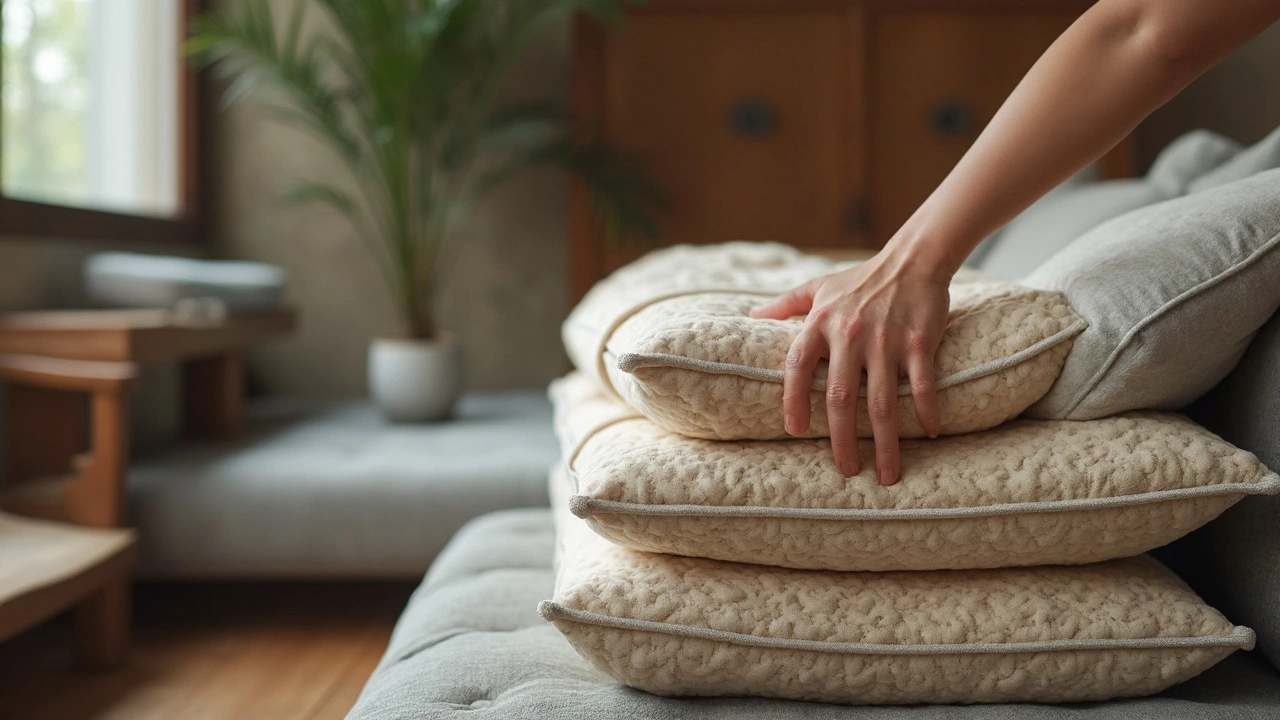So picking out a comfy sofa seems easy—until you end up plopping down and realizing it feels like a cheap motel mattress after just a few months. The secret culprit? Foam density. Most folks have no idea what that even means but trust me, it’s what decides whether your couch turns into a saggy mess or stays feel-good for movie nights—kid tumbles and all.
Here’s what most stores don’t tell you: Foam density is about how much material is packed into a cushion, not just how soft or hard it feels. You’ll see numbers like 1.5, 2.0, 2.8—these are pounds per cubic foot, measuring how heavy the foam is. Higher numbers mean more foam stuffed into the same space, which usually means more support and longer life.
Quick fact: The super squishy feel in the showroom? It often means a low-density foam that’s comfy day one but breaks down way faster. High-density foam, even if it starts out firmer, holds its shape and gives the support your back secretly craves after you’ve binged a whole season on it. You don’t want to buy twice if you can help it.
- What Foam Density Actually Means
- How Density Impacts Sofa Comfort
- Choosing the Right Density Range
- High-Density vs. Low-Density: The Real-World Difference
- Tips for Picking the Right Sofa Cushion
What Foam Density Actually Means
If you’ve ever poked a sofa cushion and thought, “Why do some feel heavy and others squish down right away?” it’s all about foam density. This is literally how much foam material is packed into one cubic foot of space. It’s measured in pounds per cubic foot (PCF). Higher density, more packed in, less air—think of it as the difference between a fully loaded baked potato and one that’s mostly air on the inside.
Here’s the deal: foam density isn’t the same as firmness. Weird, right? Two cushions can feel just as soft, but one craters after a year while the other still bounces back. Density tells you how likely it’ll last and how well it supports your weight. The sofa foam density number is your clue—it tells you if the cushion is made to last or just look pretty for a few months.
Here’s a handy comparison you won’t see in most stores:
| Density (PCF) | Lifespan | Common Use |
|---|---|---|
| 1.2 - 1.5 | 1-2 years | Rental or low-budget sofas |
| 1.8 - 2.2 | 5-7 years | Quality home sofas |
| 2.5+ | 7-10+ years | High-end or premium sofas |
The main thing to remember is: higher-density foam usually means better support and longer cushion life. Don’t just go by what feels nice in the showroom—grab the manufacturer’s spec sheet and check that PCF number. My kids, Cyrus and Delphi, have absolutely destroyed low-density cushions with a single round of indoor trampolining, but the high-density foam is still going strong. If you want a sofa that handles daily life and keeps its feel, pick density with your eyes open, not just your hand.
How Density Impacts Sofa Comfort
Foam density shapes basically every part of your sofa experience—the feel, the support, even how rough or cushy your nap turns out. People usually mix up density with firmness, but those are different things. Density is about how much foam is crammed together inside the cushion. Firmness is just how hard it feels when you first sit.
Here's where density counts. A cushion with low density (think 1.2 or 1.5 pounds per cubic foot) feels soft and inviting at the start, but it doesn't last. That squishiness means you’re more likely to see sagging and butt-prints in just six months. If you’ve ever sat on a sofa that’s all lumpy or where you can feel the frame, that’s a low-density problem.
With sofa foam density at the core, higher-density foam (like 1.8 to 2.8 pounds per cubic foot) gives real, consistent support. It stands up to daily use—even the assaults from kids, pets, or those marathon gaming sessions my son Cyrus loves. It helps the cushion pop back to its original shape, instead of looking tired. High density also means better shock absorption, so you aren’t slamming straight through to the base every time you plop down.
Another thing: High-density foam dodges that classic sofa problem where everyone ends up fighting for the least-saggy cushion. Instead, your whole couch keeps its comfort zone. That durability means money saved in the long run, since you won’t need to replace your cushions each year. If the cushion tag doesn’t show density, ask. If they can’t answer, it’s usually not the best option.

Choosing the Right Density Range
So, what’s the magic number for sofa foam? If you’re after comfort that lasts, aim for foam with a density between 1.8 and 2.8 pounds per cubic foot. Anything below 1.8 is pretty much guaranteed to break down fast. You’ll notice it in sagginess, flat cushions, or even weird lumps after a year or two. The higher end—over 2.5—is what a lot of furniture makers now call "high-resilience" foam, and it’s what’s packed into sofas built for families, rentals, and basically anywhere the couch sees a lot of rough use.
I’ve tested a lot of couches, and the sweet spot for most folks really sits around 2.0-2.5 pounds per cubic foot. That’s supportive enough for daily lounging, won’t squash right away, and still gives you that "sinks in a little" feel you want from a living room soft spot. Go higher if you like things extra firm or if your household is just tough on furniture (hello, kids and pets).
Quick tip: Don’t just trust labels. Ask about the actual sofa foam density by number, because some budget sofas use low-density foam but claim their cushions are "high quality." If you can’t get a straight answer, move on to the next store. Your back will thank you.
- 1.5 lbs/ft³ or lower: Not ideal. Early sagging is almost guaranteed.
- 1.8 lbs/ft³: Minimum for basic home sofas, but still on the cheap side.
- 2.0-2.5 lbs/ft³: Balanced comfort and durability for most families.
- 2.8 lbs/ft³ or more: Firm and long-lasting, perfect if you want investment-grade cushions.
Choosing right doesn’t have to get technical—just focus on this range, ask for real numbers, and you’ll end up with a sofa that won’t quit on you before you’re ready to swap it out for style alone.
High-Density vs. Low-Density: The Real-World Difference
Let’s cut to the chase. When you hear folks say “high-density” or “low-density” foam, they're really talking about how much support and durability you’re getting for your buck. Here’s a head-to-head breakdown that actually matters when you’re buying a new couch.
| Foam Type | Density (lbs/ft³) | Lifespan (Years) | Best For |
|---|---|---|---|
| Low-Density | 1.2 - 1.8 | 2-3 | Light use, guest rooms |
| Medium-Density | 1.8 - 2.2 | 4-6 | Everyday use |
| High-Density | 2.2+ | 7-10+ | Main living spaces, families, rentals |
Already noticing a trend? Low-density foam (usually under 1.8 lbs/ft³) feels soft and cheap, but it breaks down fast. If you’ve ever seen cushions sagging after just a year, that's probably low-density foam inside. High-density options (2.2 lbs/ft³ and up) keep their shape and pop, even with pets, kids, or partners who treat the couch like a trampoline.
Here’s what my own family learned the hard way: We got a discount sofa with low-density foam for the playroom. Looked and felt fine at first, but within 18 months, Cyrus said it was “like sitting in a hole.” We switched to a high-density number in the living room—still takes the daily beating, and isn’t anywhere close to flat almost four years later.
“High-density couch cushions retain support and reduce sagging up to 50% longer than low-density options, especially under daily use,” says Terry Quillen, upholstery materials expert at Cushion Source.
Why the big difference? Foam density really decides how much the internal bubbles collapse over time. Less dense foam = more air, less material, and faster wear. High-density foam has more actual “stuff” inside, so cushions bounce back instead of giving out.
- If you want your sofa to hold up in a busy house, always go for sofa foam density of at least 2.0 lbs/ft³.
- For guest rooms or spots you barely use, you can get away with less, but don’t expect longevity.
- If you’re unsure about a sofa, ask the salesperson for the actual foam density. If they don’t know, that’s usually a red flag.
Bottom line: High-density foam costs a bit more up front, but saves you money and hassle down the line. Sofas with this kind of cushion won’t quit on you after a year or two—think 7 years or more before you even notice a change.

Tips for Picking the Right Sofa Cushion
Don’t just trust your butt—test, check, and ask before making a decision. If you want a sofa that stays comfortable and holds up, here’s what really matters.
- Check the density number first. For the average family sofa, aim for foam density around 1.8–2.5 lbs/ft³. If you’ve got rambunctious kids or people who cough up on the couch every day, shoot closer to 2.2 or higher for that sweet spot of lasting support and soft landing.
- Ask about the foam grade—honest salespeople will show you the tag or specs. If they dodge the question, it’s probably low quality.
- Sit on the same spot for five minutes. Good cushions bounce back instead of leaving a dent behind. If you stand up and it takes ages to return to shape, it’s a bad sign.
- Look for sofas with a mix of high-density foam and a thinner soft layer on top (sometimes called a "sandwich" cushion). You get the best of both worlds: comfort up front and a strong base that won’t quit.
- Consider removable covers—kids, pets, snacks… enough said. Easy-to-wash covers keep everything fresh and hygienic.
Want a quick cheat sheet? Here’s a handy breakdown of recommended foam densities by use:
| Usage | Recommended Foam Density (lbs/ft³) |
|---|---|
| Light Use (guest room, formal room) | 1.5 – 1.8 |
| Everyday Family Use | 1.8 – 2.2 |
| Heavy Use (kids, rentals, lots of lounging) | 2.2 – 2.8 |
And don’t forget—the best sofa cushions aren’t just about density but also how thick the cushion is. Thicker foam lasts longer and gives more support with the right density. Never be shy to unzip the cover and check what’s inside before you buy. Your back—and your wallet—will thank you in a year or two.

